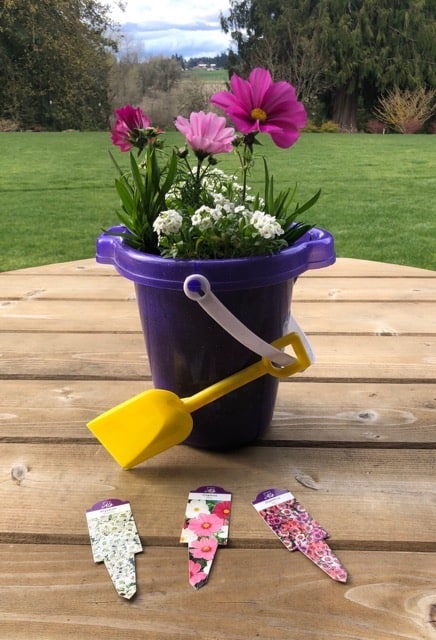
Try this fun planting project from Al’s Garden Center to bring more butterflies into your yard!
Kids love butterflies! So encourage your child’s sense of connection to the natural world and invite butterflies into your backyard by planting a butterfly garden. This project calls for a summery beach bucket as a planter, but if you have the time and space, consider dedicating an area in your landscape as a butterfly oasis. Butterflies love a colorful array of nectar-producing plants. Be sure to also include host plants to feed the caterpillar stage of their life cycles. Cosmos, dianthus, sweet alyssum, asters, nicotiana, nasturtiums, snapdragons, petunias, lantana, daisies and sunflowers are all great choices for your garden. With the appropriate plantings, a butterfly garden provides opportunities to educate your children about the life cycle of the butterfly, allowing them to view each stage of growth and explore the intricate relationships of plants and animals.
Materials
Colorful beach bucket with shovel
Potting soil
Flowers that attract butterflies and/or host plants for caterpillars (see above)
Instructions
1. Fill your bucket with potting soil.
2. Plant taller flowers such as cosmos or daisies toward the back or center of your bucket.
3. Fill in the outside edges with clumping plants (such as dianthus) or trailing flowers (such as alyssum).
4. Place your planter outdoors in a sunny location.
5. Water your planter as needed. Watch for butterflies and keep a journal of your discoveries. Transplant your flowers into an outdoor garden bed if they become too crowded in the bucket.
Fun Facts about Butterflies
› A butterfly’s life cycle is made up of four parts: egg, larva (caterpillars), pupa (chrysalis) and adult.
› Butterflies attach their eggs to leaves with a special glue.
› Most caterpillars are plant eaters (herbivores).
› Butterflies can live in the adult stage anywhere between a week and a year, depending on the species.
› Butterflies have four wings.
› Butterflies have taste receptors on their feet.
› Scientists estimate there are between 15,000 and 20,000 different species of butterflies.
Go to the Al’s Garden & Home YouTube channel to find videos for more Kids’ Club projects!
Amy Bigej is the education coordinator for Al’s Garden & Home. She loves working on fun, educational and gardening-themed kids’ projects for the monthly Kids’ Club.
- Summer Camps with Space - April 16, 2024
- Portland Half-Day Summer Camps - April 16, 2024
- Summer Camps with Space - April 15, 2024





